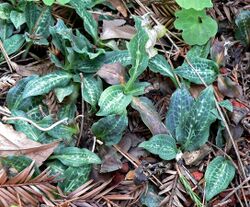Biology:Goodyera oblongifolia
| Goodyera oblongifolia | |
|---|---|

| |
| Scientific classification | |
| Kingdom: | Plantae |
| Clade: | Tracheophytes |
| Clade: | Angiosperms |
| Clade: | Monocots |
| Order: | Asparagales |
| Family: | Orchidaceae |
| Subfamily: | Orchidoideae |
| Tribe: | Cranichideae |
| Genus: | Goodyera |
| Species: | G. oblongifolia
|
| Binomial name | |
| Goodyera oblongifolia | |
| Synonyms[1] | |
| |
Goodyera oblongifolia is a species of orchid known by the common names western rattlesnake plantain and giant rattlesnake plantain. It is native to much of North America, particularly in the mountains of the western United States and Canada , from Alaska to northern Mexico, as well as in the Great Lakes region, Maine, Quebec and the Canadian Maritime Provinces.[1][2][3]
Goodyera oblongifolia is most commonly found in mountain forests, often in the understory of conifers. This orchid forms a patch of broad lance-shaped to oval-shaped leaves at the ground, each 4 to 9 centimeters long. The leaf is dark green and in this species the midrib is streaked with white. There is often also white netlike veining on the leaf. The plant produces an erect inflorescence up to about 30 centimeters tall. The top of the inflorescence has many white orchid flowers which may all face the same direction on the stalk, or be spirally arranged about it.[4][5][6]
The common name stems from the leaves, which have marks resembling snakeskin; the plant is also said to have been used to treat snakebites.[7]
References
- ↑ 1.0 1.1 "Goodyera oblongifolia". World Checklist of Selected Plant Families (WCSP). Royal Botanic Gardens, Kew. http://wcsp.science.kew.org/namedetail.do?name_id=91873.
- ↑ Kallunki, Jacquelyn A. (2002), "Goodyera oblongifolia", in Flora of North America Editorial Committee, Flora of North America North of Mexico (FNA), 26, New York and Oxford, http://www.efloras.org/florataxon.aspx?flora_id=1&taxon_id=242101640
- ↑ "Goodyera oblongifolia", County-level distribution map from the North American Plant Atlas (NAPA) (Biota of North America Program (BONAP)), 2014, http://bonap.net/MapGallery/County/Goodyera%20oblongifolia.png
- ↑ Gleason, H. A. & A.J. Cronquist. 1968. The Pteridophytoa, Gymnospermae and Monocotyledoneae. 1: 1–482. In H. A. Gleason New Britton and Brown Illustrated Flora of the Northeastern United States and Adjacent Canada (ed. 3). New York Botanical Garden, New York
- ↑ Hickman, J. C. 1993. The Jepson Manual: Higher Plants of California 1–1400. University of California Press, Berkeley.
- ↑ Cronquist, A.J., A. H. Holmgren, N. H. Holmgren & Reveal. 1977. Vascular Plants of the Intermountain West, U.S.A. 6: 1–584. In A.J. Cronquist, A. H. Holmgren, N. H. Holmgren, J. L. Reveal & P. K. Holmgren (eds.) Intermountain Flora, Hafner Pub. Co., New York.
- ↑ Fagan, Damian (2019). Wildflowers of Oregon: A Field Guide to Over 400 Wildflowers, Trees, and Shrubs of the Coast, Cascades, and High Desert. Guilford, CT: FalconGuides. pp. 65. ISBN 978-1-4930-3633-2. OCLC 1073035766. https://www.worldcat.org/oclc/1073035766.
External links
- Jepson eFlora taxon page
- Fire Effects Information System
- Washington Native Orchid Society
- Portland Nursery
- Calflora, California Flora taxon report
- Plants For a Future
- Go Orchids, North American Orchid Conservation Center
- Go Botany, New England Wildflower Society
- E-flora BC, Electronic Atlas of the Flora of British Columbia
Wikidata ☰ Q1596782 entry
 |

